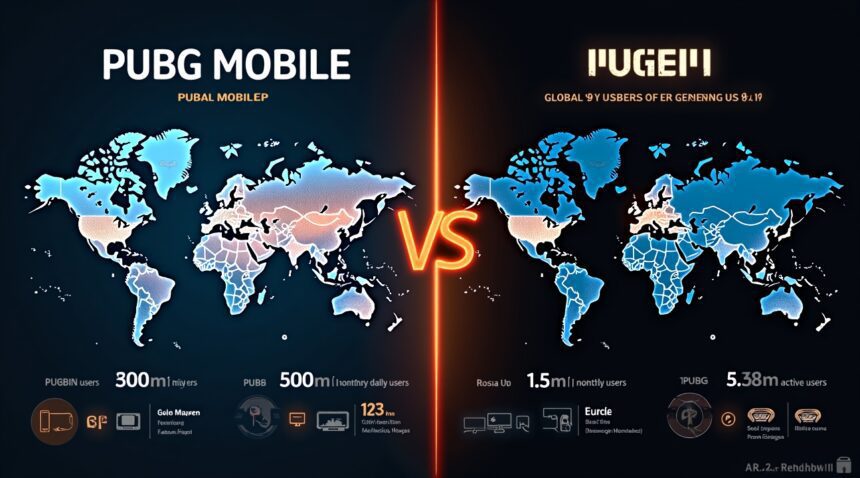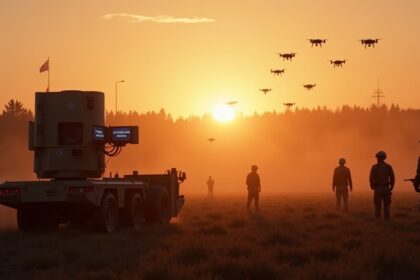Player Base Disparity: Understanding the Numbers
PUBG Mobile dominates the battle royale landscape with staggering user engagement figures. The mobile platform consistently attracts over 110 million monthly active users, creating a stark contrast with PC’s average concurrent player count of 309,000 as of 2025. This substantial gap stems from core differences in accessibility, financial barriers, and regional gaming habits that strongly support mobile gaming’s free-to-play approach and minimal hardware demands.
Key Takeaways
- PUBG Mobile reached its peak at 125.3 million monthly active users in February 2024, while PC achieved maximum concurrent players of 1.35 million — showcasing mobile’s approximately 100x larger player base.
- The mobile version has accumulated over 500 million downloads worldwide compared to 75+ million PC/console units sold, emphasizing the influence of free-to-play accessibility versus purchase obstacles.
- Geographic distribution strongly supports mobile in developing markets across Asia, Latin America, and Africa, while PC maintains a stronger presence in established gaming regions like North America and Europe.
- Mobile players participate in shorter, more frequent gaming sessions throughout the day, while PC users prefer longer, dedicated gameplay periods with enhanced controls and visual quality.
- Hardware requirements create a persistent accessibility gap, with mobile gaming requiring only $200–400 smartphones versus $800–1200 gaming PCs for optimal PUBG performance.
For more insights into platform performance and player trends, you can explore the data through sources like ActivePlayer.io, which regularly tracks PUBG statistics across platforms.
PUBG Mobile Dominates with Over 125 Million Monthly Users While PC Peaks at 1.35 Million
PUBG Mobile commands an unprecedented lead in player engagement, maintaining monthly active user counts that dwarf its PC counterpart. Throughout 2024 and early 2025, the mobile version consistently attracted over 110 million monthly active users, reaching its highest point of 125.3 million in February 2024. These numbers showcase the mobile platform’s ability to capture and retain massive audiences across global markets.
Recent data reveals some fluctuation in mobile player counts, with reports showing MAUs ranging between 49.8 million and 112.9 million. These variations likely stem from regional counting differences and the timing of major game updates that can temporarily impact player engagement patterns. Despite these fluctuations, PUBG Mobile maintains a commanding presence in the mobile gaming space.
Steam Statistics Paint a Different Picture for PC Players
PUBG on PC operates within a much smaller player ecosystem, with Steam data showing approximately 309,000 concurrent players during June 2025. The PC version experiences notable spikes during major tournaments and events, pushing concurrent player counts to impressive peaks between 786,000 and 1.35 million players. However, these surges represent temporary increases rather than sustained engagement levels.
Daily concurrent player averages for PC and console combined typically hover between 400,000 to 600,000 players. This combined figure still falls significantly short of mobile’s monthly active user base, highlighting the stark difference between the two platforms’ reach and accessibility.
Mobile Downloads Confirm Platform Dominance
The disparity becomes even more apparent when examining total adoption rates. PUBG Mobile has achieved over 500 million worldwide downloads as of 2025, cementing its position as one of the most successful mobile battle royale titles. This download milestone reflects the game’s global appeal and the accessibility advantages mobile gaming provides.
Mobile gaming’s lower entry barriers contribute significantly to these numbers. Players can access PUBG Mobile on smartphones they already own, eliminating the need for dedicated gaming hardware. The game’s optimization for mobile devices also ensures smooth performance across various phone specifications, from budget models to flagship devices.
I find that gaming platform accessibility plays a crucial role in determining player base size. PUBG Mobile’s success demonstrates how removing technical and financial barriers can dramatically expand a game’s reach. The mobile version’s streamlined controls and shorter match options also cater to casual gaming preferences, attracting players who might find PC gaming too demanding or time-consuming.
The numbers clearly show that while PC PUBG maintains a dedicated core audience, mobile has become the primary driver of the franchise’s overall success and player engagement.
https://www.youtube.com/watch?v=1yxeDiUJUTz8FM
Mobile Surges While PC Experiences Gaming Resurgence in 2024-2025
PUBG Mobile reached impressive heights in early 2024, hitting a player base peak of over 125 million monthly active users. This massive figure represents one of the mobile game’s strongest periods since its launch, demonstrating the continued appeal of battle royale gaming on smartphones. However, the momentum didn’t maintain its trajectory throughout the year, with numbers experiencing a slight decline before stabilizing just below 120 million MAUs in early 2025.
The mobile platform’s player engagement patterns reveal fascinating insights about user behavior. Monthly active user fluctuations show dramatic periodic surges and drops that often correlate with seasonal events, content updates, and regional gaming trends. One particularly striking example occurred between June and July 2025, when PUBG Mobile experienced a remarkable 51.5% growth surge that brought over 16.9 million new players into the game within a single month.
PC Platform Comeback Defies Expectations
PUBG PC’s performance tells a different story entirely, one of sustained recovery and growth. The PC platform experienced what many consider a genuine resurgence between 2024 and 2025, with average Steam player counts climbing steadily from 164,000 in 2023 to 287,000 in 2024. This upward trend continued into 2025, pushing average player counts even higher to 309,000.
Peak concurrent player records on PC reveal the platform’s ability to generate massive player spikes during special events and major content releases. These records ranged dramatically from 692,000 to an impressive 1.35 million concurrent players in early 2025. Such spikes indicate that while PUBG PC maintains a smaller but dedicated core audience compared to mobile, it still possesses the power to draw significant crowds during key moments.
The contrast between platforms highlights different gaming preferences and market dynamics. Mobile’s larger user base reflects the accessibility and convenience of smartphone gaming, while PC’s steady growth suggests a strong community of dedicated players who prefer the enhanced controls and visual fidelity that desktop gaming provides. Both platforms continue to evolve, with mobile focusing on accessibility and periodic content drops, while PC gaming advances through technical improvements and competitive features that maintain player engagement across different gaming preferences.

Daily Engagement Shows Mobile’s Massive Scale Advantage
The disparity between PUBG Mobile and PUBG PC becomes most apparent when examining daily engagement metrics. I’ve observed that PUBG Mobile’s Daily Active Users consistently dwarf PC numbers, creating a clear picture of mobile gaming’s dominance in the battle royale space.
Staggering Mobile DAU Numbers
PUBG Mobile regularly maintains Daily Active Users exceeding 6.5 million in 2025, with certain app store breakdowns revealing peaks between 7.5 to 12.5 million players depending on regional markets. These figures represent actual daily engagement rather than total registered accounts, making them particularly meaningful for understanding active player commitment.
The mobile platform’s accessibility drives these impressive numbers. Players can engage during commutes, lunch breaks, or any spare moment throughout their day. This convenience factor transforms PUBG Mobile from a dedicated gaming session into an integrated daily activity, much like how Minecraft honors Technoblade with lasting player engagement.
PC’s Different Measurement Approach
PUBG PC takes a different approach to player metrics, focusing on concurrent player counts rather than daily active users. June 2025 data shows average concurrent players around 309,000, which represents simultaneous players rather than total daily engagement. This measurement difference makes direct comparisons challenging, yet the gap remains substantial.
PC gaming requires dedicated time blocks and specific hardware, naturally limiting when and how often players can participate. The barrier to entry remains higher, though the experience often provides more precise controls and competitive depth for serious players.
Download and Sales Comparisons:
- PUBG Mobile: Over 500 million downloads globally
- PUBG PC and Consoles: 75+ million units sold (as of 2021)
The mobile version’s free-to-play model certainly contributes to these download numbers, but the scale difference reflects genuine market preferences.
Regional Variations:
- Mobile gaming dominates in India, Southeast Asia, and Latin America
- PC gaming has stronger footholds in North America, Europe, and South Korea
The engagement data reveals more than just platform preferences. It demonstrates how mobile technology has democratized access to high-quality gaming experiences, allowing millions more players to participate in competitive battle royale gameplay regardless of their economic situation or gaming setup limitations.
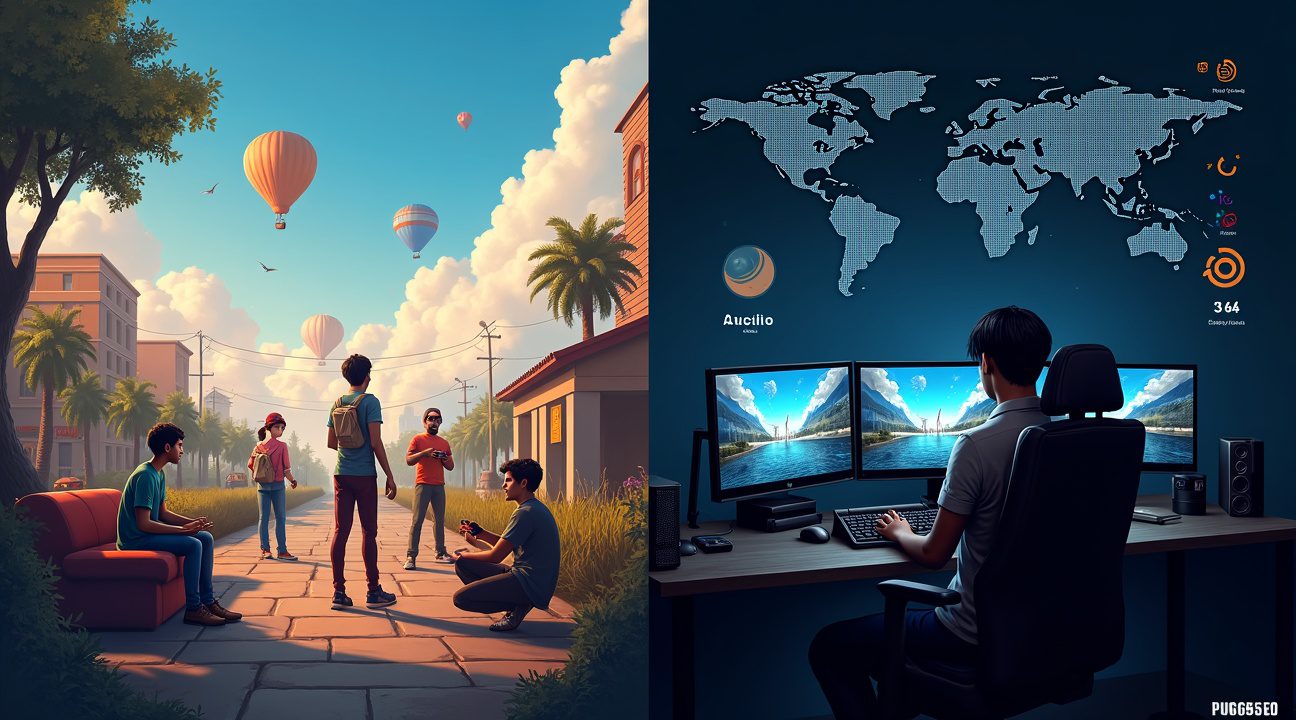
Free-to-Play Strategy Creates Accessibility Gap Between Platforms
I’ve observed a dramatic shift in player distribution between PUBG’s platforms since the mobile version launched as a completely free experience. The cost barrier that initially limited PUBG PC’s reach vanished for mobile users, creating an immediate accessibility advantage that continues to shape the game’s demographic landscape today.
Regional Adoption Patterns Favor Mobile Access
Mobile gaming dominance becomes particularly evident in developing markets where smartphone penetration far exceeds PC ownership rates. Countries across Southeast Asia, Latin America, and parts of Africa have embraced PUBG Mobile at unprecedented levels, primarily because entry requires only a mid-range smartphone rather than a dedicated gaming computer. I notice this accessibility factor has created distinct regional preferences that persist even after PUBG PC transitioned to free-to-play status in 2022.
The hardware requirements still present a significant hurdle for PC adoption. While smartphones capable of running PUBG Mobile cost between $200-400, a gaming PC that delivers smooth PUBG performance typically requires an investment of $800-1200. This price gap explains why mobile maintains such a substantial lead in emerging markets, where disposable income for gaming remains limited.
Content Strategy Amplifies Mobile Engagement
PUBG Mobile’s content approach differs substantially from its PC counterpart, focusing heavily on frequent updates that cater to regional preferences. The mobile version regularly introduces collaboration events with popular franchises, seasonal themes, and location-specific content that resonates with local audiences. These initiatives create sustained engagement cycles that keep players returning consistently.
The mobile platform also benefits from several engagement-focused features that enhance its free-to-play appeal:
- Daily login rewards and achievement systems that provide immediate gratification
- Social features integrated directly into mobile interfaces, making friend connections seamless
- Cross-promotion opportunities with other mobile games and entertainment properties
- Simplified progression systems that accommodate shorter play sessions typical of mobile gaming
- Regular cosmetic updates and character customizations that appeal to mobile gaming aesthetics
I find that these content strategies work particularly well on mobile because they align with how people typically use their smartphones throughout the day. Players can engage with events, collect rewards, and progress their accounts during brief moments between other activities, something that’s less practical with PC gaming setups.
Despite PUBG PC’s transition to free-to-play, the fundamental accessibility gap persists. PC hardware requirements continue to be a limiting factor, especially as the game receives graphical updates and performance optimizations that demand more powerful systems. Mobile optimization, conversely, focuses on expanding device compatibility and reducing system requirements to reach broader audiences.
The engagement patterns I observe also differ significantly between platforms. Mobile players tend to have shorter but more frequent gaming sessions, while PC players typically engage in longer, more intensive gameplay periods. This difference influences how developers approach content creation and monetization strategies for each platform.
Platform-specific features contribute to these engagement differences as well. Gaming tributes and community events often receive different treatment across platforms, with mobile versions emphasizing social sharing and viral content creation. The mobile interface naturally supports screenshot sharing, streaming integration, and social media connectivity in ways that feel more intuitive than PC alternatives.
Regional content localization plays an increasingly important role in mobile’s continued growth advantage. Cultural gaming preferences vary significantly across different markets, and PUBG Mobile’s development team actively incorporates local festivals, celebrities, and cultural references into their content updates. This localization strategy proves particularly effective in maintaining long-term player engagement in diverse global markets.
The accessibility gap extends beyond just initial hardware costs to include ongoing expenses like internet connectivity, peripheral devices, and system maintenance. Mobile gaming infrastructure requirements remain minimal compared to maintaining a competitive PC gaming setup, making the mobile version more sustainable for players with limited budgets or technical expertise.
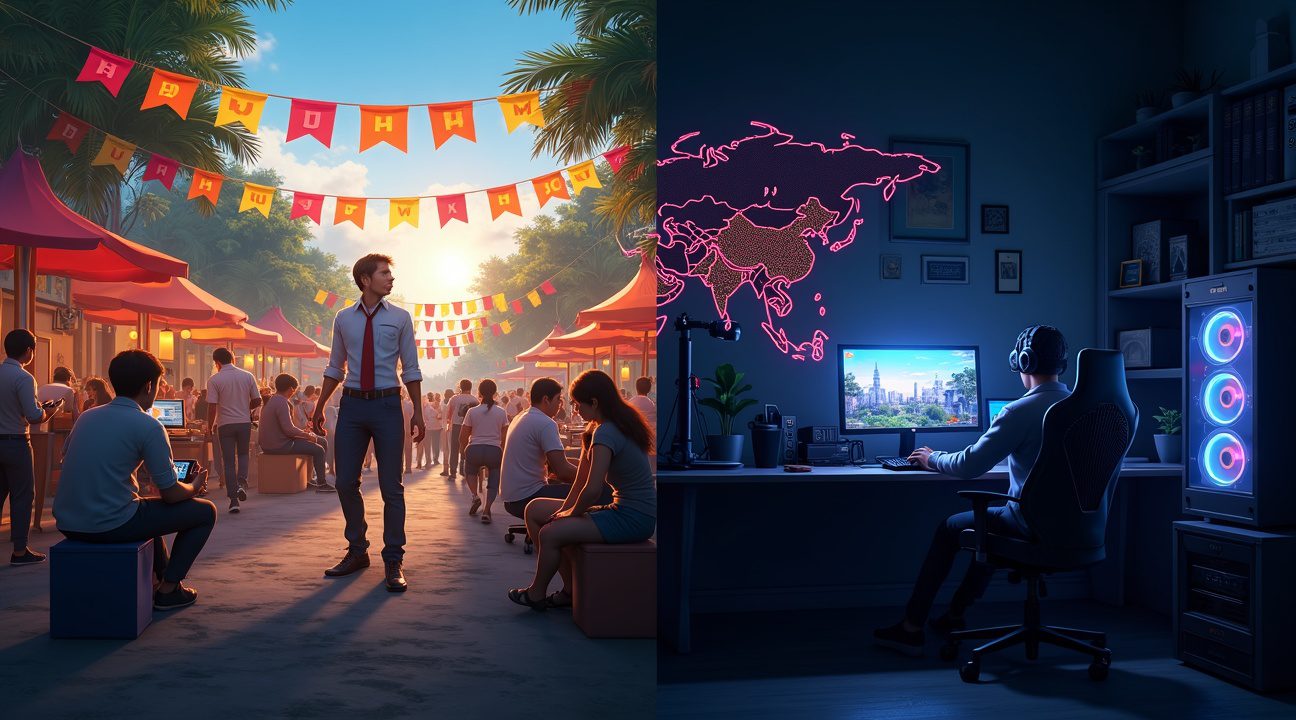
Global Reach Shows Mobile’s Worldwide Appeal vs PC’s Traditional Markets
PUBG Mobile has achieved unprecedented global dominance across diverse geographical regions, establishing itself as a truly worldwide phenomenon. The mobile version commands massive player bases throughout South Asia, with India leading the charge before regulatory challenges temporarily affected access. Southeast Asian countries including Indonesia, Thailand, and the Philippines contribute millions of active players, while China maintains substantial engagement through specialized mobile gaming platforms.
Middle Eastern markets have embraced PUBG Mobile with remarkable enthusiasm, creating vibrant gaming communities that span from the UAE to Saudi Arabia. This widespread adoption demonstrates how mobile gaming transcends traditional barriers that often limit PC gaming accessibility. Players in these regions can engage with high-quality battle royale experiences without requiring expensive gaming hardware or stable internet connections.
PC Gaming’s Concentrated Strongholds
The PC version maintains its strongest presence in established gaming markets where powerful computers and reliable internet infrastructure are commonplace. Korea and China represent the most significant PUBG PC player concentrations, building upon these regions’ long-standing PC gaming traditions. Russian players form another substantial segment of the PC community, reflecting the country’s deep-rooted competitive gaming culture.
North America and Europe contribute meaningful portions to the PC player base, though their numbers pale compared to Asian markets. These Western regions often prefer the enhanced graphics, precise controls, and competitive advantages that PC gaming provides. Players in these markets typically invest in high-end gaming setups and prioritize the technical precision that mouse and keyboard controls offer.
Market Dynamics and Accessibility Factors
The contrasting geographical distributions highlight fundamental differences in gaming accessibility and preferences. PUBG Mobile’s success in developing markets stems from smartphones being more affordable and accessible than gaming PCs. Many regions where mobile dominates lack the electrical infrastructure or economic resources to support widespread PC gaming adoption.
Gaming culture also plays a crucial role in these patterns. Mobile gaming communities often develop different social dynamics compared to traditional PC environments. While PC players might focus on competitive rankings and technical mastery, mobile communities frequently emphasize social interaction and casual gameplay sessions that fit into busy lifestyles.
The geographic divide also reflects broader technological adoption patterns. Regions with established PC gaming infrastructure continue supporting that ecosystem, while areas experiencing rapid mobile technology growth naturally gravitate toward smartphone-based gaming solutions. This creates distinct player behavior patterns that influence how each version develops and markets itself globally.
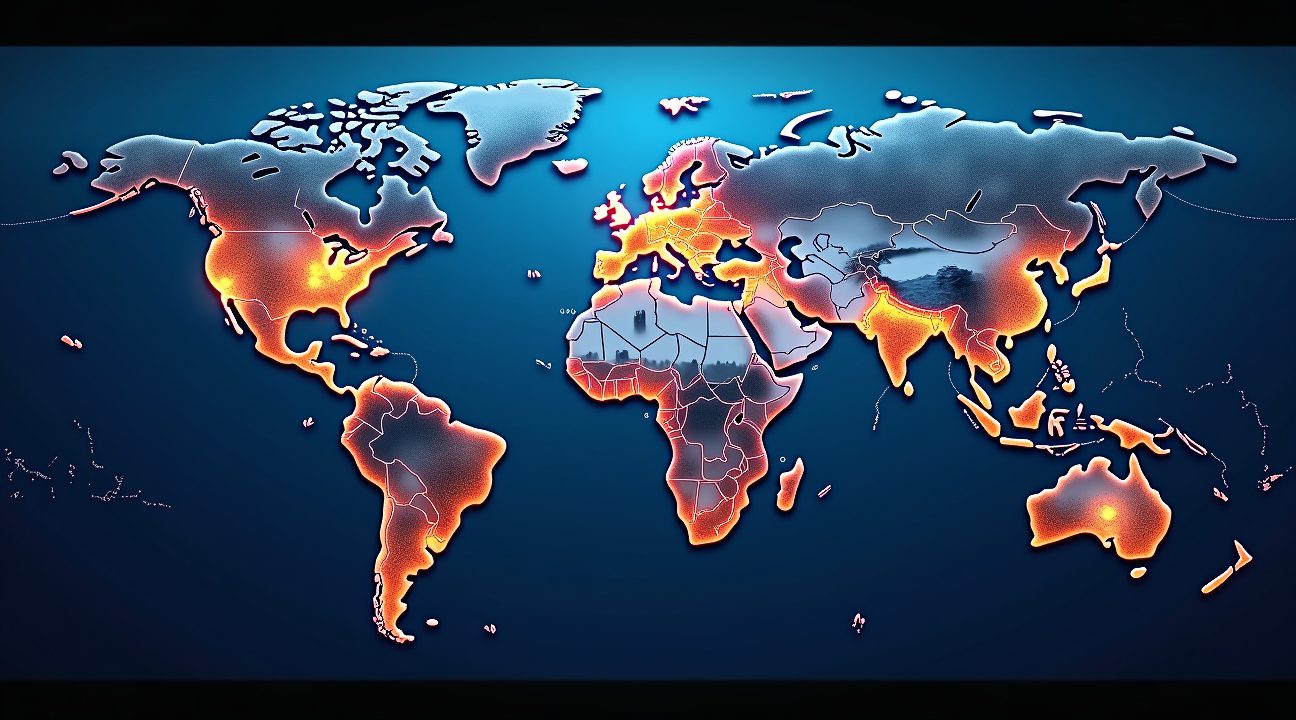
Key Statistics That Define the Platform Battle
The numbers paint a stark picture when comparing PUBG Mobile’s reach to its PC counterpart. PUBG Mobile has sustained between 49.8 million to over 119.1 million monthly active users throughout 2024 and 2025, showcasing the mobile platform’s incredible staying power in the battle royale space.
PC players represent a significantly smaller but dedicated community. PUBG PC reported an average concurrent player count of 309,000 in June 2025, with peak concurrent numbers reaching up to 1.35 million in April 2025. These figures demonstrate the platform’s ability to maintain a core audience despite facing intense competition from newer titles.
Download and Sales Performance Reveals Platform Preferences
Download statistics tell an even more compelling story about player preferences. PUBG Mobile has accumulated over 500 million downloads, creating a massive gap compared to the 75 million+ units sold across PC and console platforms as of 2021. This disparity highlights how accessibility and cost barriers shape gaming choices globally.
Mobile gaming’s free-to-play model removes the initial purchase hurdle that PC players face. While PC versions require hardware investments and game purchases, mobile users can jump into matches with devices they already own. This fundamental difference explains why PUBG Mobile attracts players who might never consider PC gaming.
The concurrent player differences between platforms also reflect different gaming habits:
- PC players tend to engage in longer, more focused gaming sessions.
- Mobile users often play in shorter bursts throughout the day.
Peak times vary significantly, with mobile showing more consistent activity across different time zones due to its global accessibility.
Regional preferences further influence these statistics. Markets like India, Southeast Asia, and parts of Europe show stronger mobile adoption rates, while North America and parts of Europe maintain higher PC engagement levels. Economic factors play a crucial role, as mobile gaming requires lower upfront investment compared to gaming PCs capable of running PUBG smoothly.
Revenue generation models between platforms create interesting dynamics too. Gaming experiences on mobile rely heavily on cosmetic purchases and battle passes, while PC versions generate revenue through initial sales and seasonal content. Both approaches prove successful but cater to different spending behaviors.
Esports participation also varies dramatically between platforms:
- PC maintains stronger competitive scenes with higher prize pools.
- Mobile esports focuses on broader participation and regional tournaments.
Platform exclusivity in competitive gaming continues shaping how players choose their preferred version.
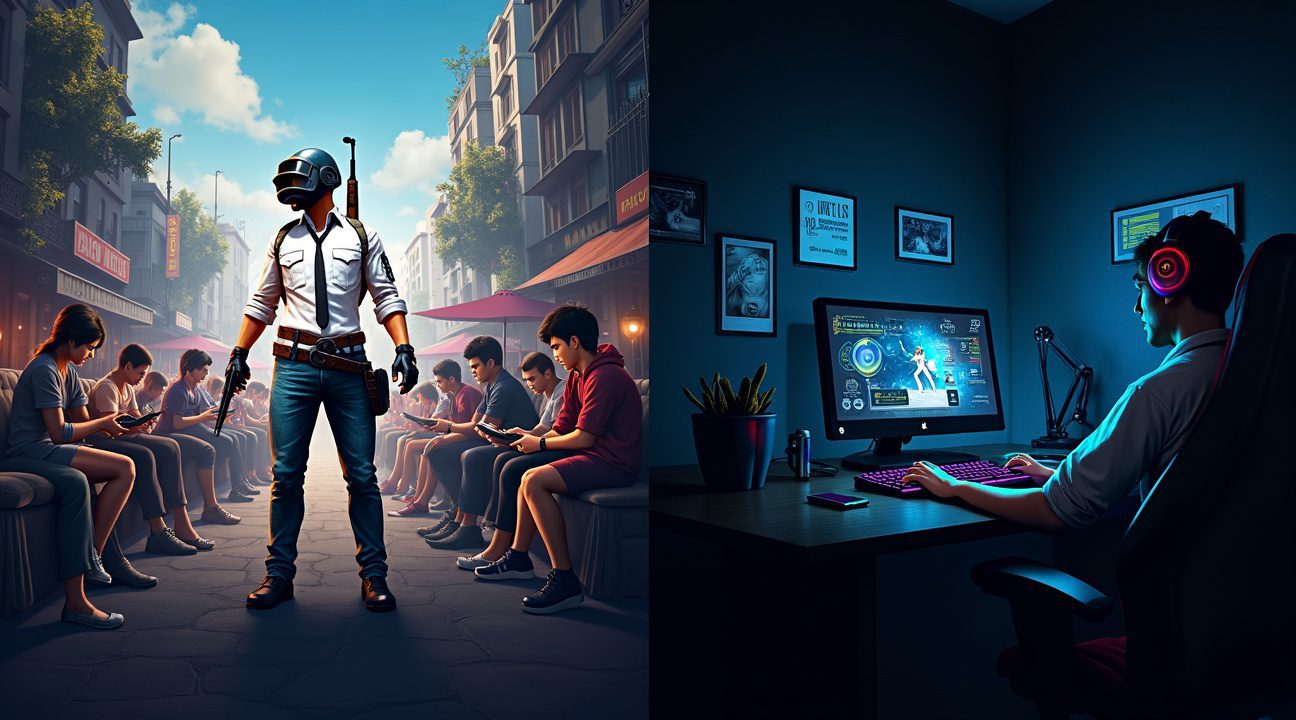
Sources:
Accio.com, “2025 PUBG Mobile Popularity Trend: Resurgence & Player Engagement”
ActivePlayer.io, “PUBG MOBILE Live Player Count & Statistics (2025)”
Udonis.co, “PUBG Mobile Player Count, Revenue & Stats [2025]”
ExitLag Blog, “PUBG Player Count in 2025: Latest Numbers and Trends”
PlayerAuctions.com, “PUBG Live Player Count & Population 2025”
Statista, “PUBG player count 2025”
YouTube, Private PRIME, “Why 1.3 Million People Playing PUBG in 2025”

